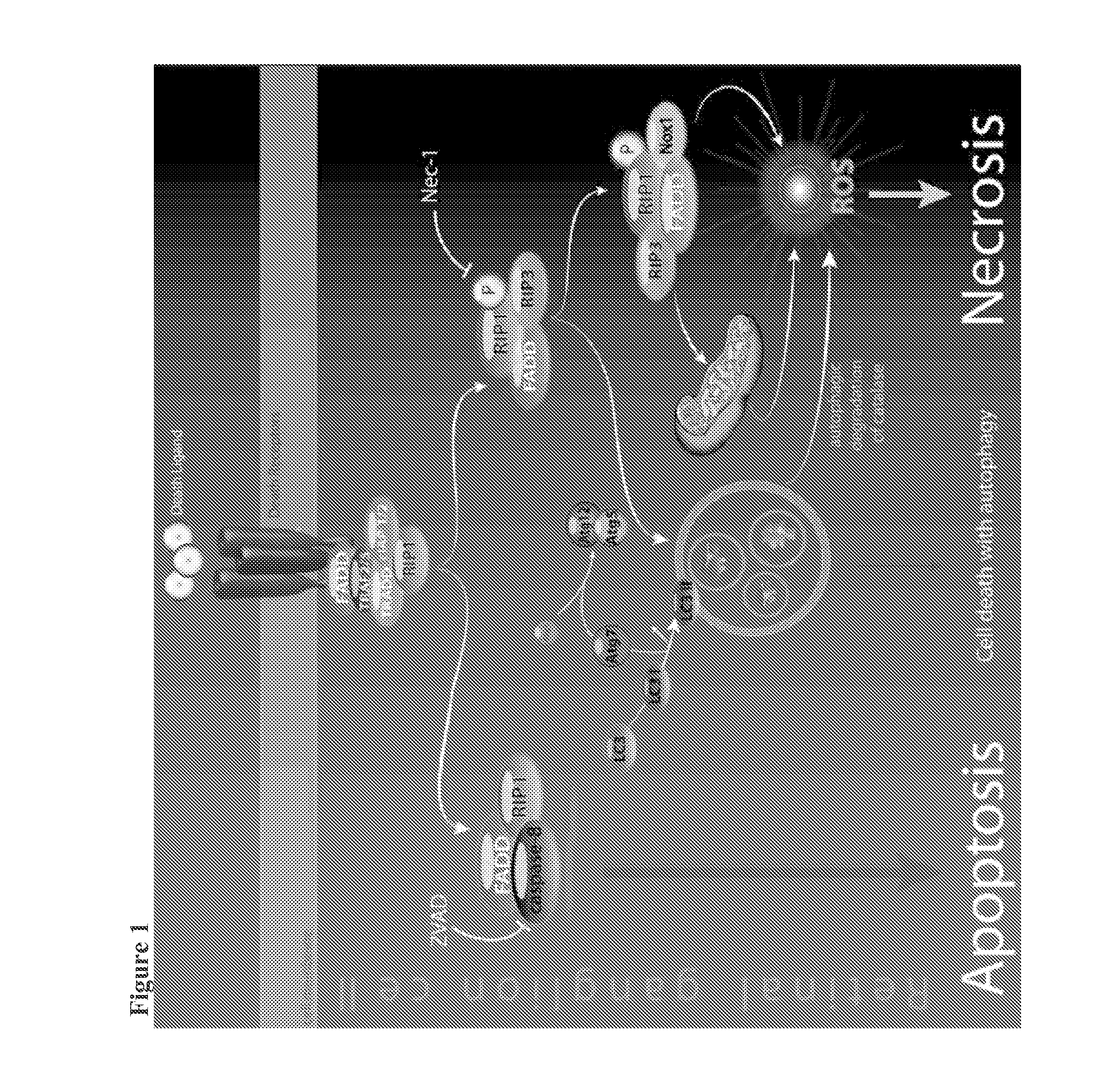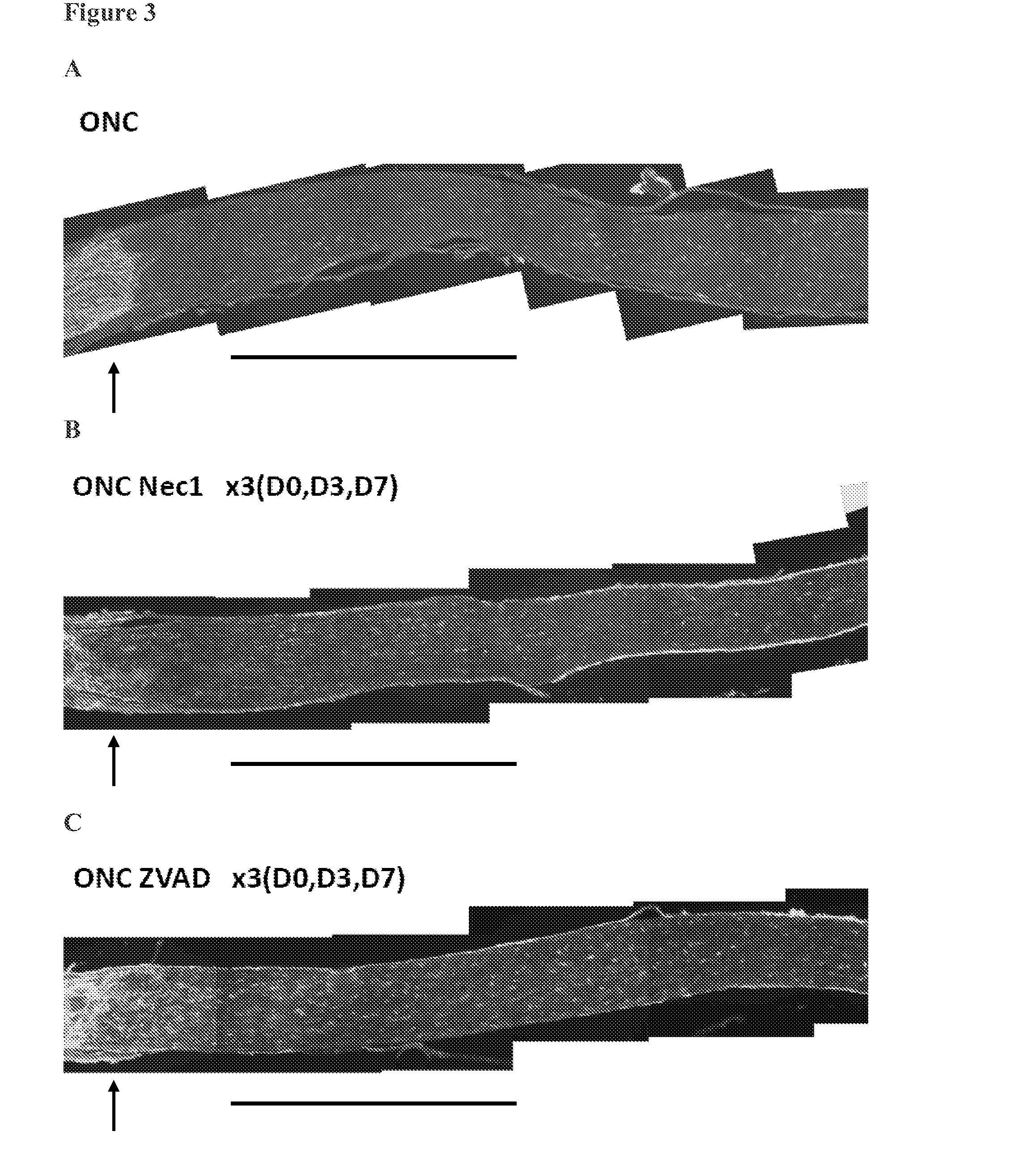Compositions comprising necrosis inhibitors, such as necrostatins, alone or in combination, for promoting axon regeneration and nerve function, thereby treating CNS disorders
a technology of necrosis inhibitors and axons, applied in the field of necrosis inhibitors, can solve the problems of axonal loss, disruption of neuronal function, and inability of the central nervous system to self-repair and regenerate, so as to promote axon growth and nerve function, preserve neuron viability, and reduce or even reverse cognitive loss
- Summary
- Abstract
- Description
- Claims
- Application Information
AI Technical Summary
Benefits of technology
Problems solved by technology
Method used
Image
Examples
example 1
Efficacy of a Necrosis Inhibitor and a Pan-Caspase Inhibitor in Promoting RGC Survival and Axon Regeneration
[0337]Like most pathways in the mature central nervous system, the optic nerve cannot regenerate if injured, leaving victims of traumatic nerve injury or degenerative diseases such as glaucoma with life-long visual losses. This situation can be, at least, partially reversed by enhancing the intrinsic growth state of retinal ganglion cells (RGCs). In this example, the efficacy of necrosis inhibitor and a pan-caspase inhibitor in promoting RGC survival and axon regeneration is investigated using a mouse optic nerve crush model.
A. A Necrosis Inhibitor in Combination with a Caspase Inhibitor Promotes RGC Survival in a Optic Nerve Crush Model
[0338]Mice were subjected to optic nerve crush surgery. Specifically, animals were anesthetized with an intraperitoneal injection of ketamine (60-80 mg / kg: Phoenix Pharmaceutical, St. Joseph, Mo.) and xylazine (10-15 mg / kg: Bayer, Shawnee Missi...
example 2
Efficacy of a Necrosis Inhibitor and a Pan-Caspase Inhibitor in a Rat Model of Motor Neuron Regeneration
[0345]The specificity of motor axon regeneration can be investigated in the rat femoral nerve. Proximally, at the site of nerve transection and suture, axons that contribute to both cutaneous and muscle branches intermingle throughout the nerve. As these axons regenerate, they have equal access to neighboring motor and sensory Schwann cell tubes in the distal nerve stump. This assures an element of “choice” at the axonal level. Distally, where the specificity of regneration is assessed, axons are segregated into terminal cutaneous and muscle branches. Motor axons are normally found only in the muscle branch, so any motor reinnervation of the cutaneous branch represents a pathfinding failure. The specificity of axon regeneration is evaluated by simultaneous application of horseradish peroxidase (HRP) to one distal femoral branch and fluoro-gold (FG) to the other. Motor-axon regener...
example 3
Efficacy of a Necrosis Inhibitor and a Pan-Caspase Inhibitor in a Rat Model of Damaged Vertebra
[0348]Two-month old Sprague-Dawley rats (200-220 g) are used. Starting from 14 days before surgical operations, the animals undergo basic walking training for the Basso, Beattie and Bresnahan (BBB) test and the grid walk test, which measure locomotor functions. At 3 days before surgical operations, the animals are subjected to basic evaluations with respect to their behaviors and movement functions.
[0349]Rats are anesthetized with 2 kg / ml of a mixture of 25 mg / ml of ketamine and 1.3 mg / ml of Rompun and subjected to L2 Ventral Laminectomy. The animals are intramuscularly injected with the antibiotic Cefalexin (5 mg / 100 g bodyweight / day) to prevent infections. Spinal cord injury is induced by opening the second lumbar vertebra of each rat and puncturing a small hole (1 mm2) in the outside of the left arcus vertebra using a microrongeur. The blade of a blade holder is inserted into the hole a...
PUM
| Property | Measurement | Unit |
|---|---|---|
| swelling | aaaaa | aaaaa |
| compositions | aaaaa | aaaaa |
| concentrations | aaaaa | aaaaa |
Abstract
Description
Claims
Application Information
 Login to View More
Login to View More - R&D
- Intellectual Property
- Life Sciences
- Materials
- Tech Scout
- Unparalleled Data Quality
- Higher Quality Content
- 60% Fewer Hallucinations
Browse by: Latest US Patents, China's latest patents, Technical Efficacy Thesaurus, Application Domain, Technology Topic, Popular Technical Reports.
© 2025 PatSnap. All rights reserved.Legal|Privacy policy|Modern Slavery Act Transparency Statement|Sitemap|About US| Contact US: help@patsnap.com



